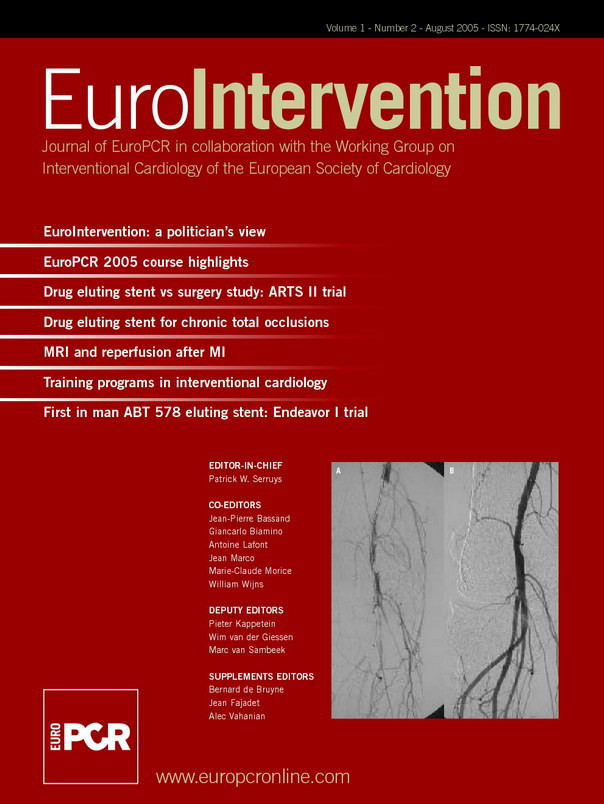This editorial refers to “Arterial Revascularisation Therapies Study Part II Sirolimus-Eluting Stents for the Treatment of Patients Multivessel De Novo Coronary Artery Lesions.” by Patrick W. Serruys et al., published in this issue of EuroIntervention.
The importance of randomization in clinical trials has been duly emphasized as a cornerstone for building evidence-based medicine. What then are we to do with a hybrid study - ARTS II - which included part of a recent multicenter randomized trial previously published (ARTS I) and a single-center single-arm registry experience (ARTS II). To further complicate this hybrid trial design, there were also hybrid statistics, both conventional and Bayesian.
The background of this trial is essential to our understanding of the role it can and should play. The multicenter ARTS I trial of patients with multivessel disease randomized to either stenting with bare metal stents or coronary artery bypass graft surgery documented that in this population of 1209 patients there was no significant difference in death, stroke, and myocardial infarction — 8.0% in the coronary artery bypass graft surgery patients (CABG) and 9.5% in the percutaneous coronary intervention (PCI) patients at one year. There was, however, an increased need for repeat revascularization with PCI; 12.3% of initial PCI patients required subsequent PCI versus 3.0% of surgical patients. In addition, 4.7% of initial PCI patients required coronary artery bypass graft surgery. While this was improved compared with conventional PTCA, there was still room for improvement.
Interventional cardiology has continued to add colors to its palette as it completes the picture of treatment strategies for cardiovascular disease. As part of this, the dramatic introduction of drug-eluting stents has the potential to eliminate the disparities still present between PCI and coronary artery bypass graft surgery as documented in ARTS I in terms of the need for repeat revascularization.
It was against this backdrop that the authors planned the ARTS II trial with the stated objective of “obtaining information on the Sirolimus eluting stent and multivessel disease in a population whose baseline characteristics were to be of at least similar complexity and comparable to ARTS I.”
Such a trial design places some constraints and limitations on the extent of interpretation that include 1) the inability to perform a non inferiority comparison, 2) the requirement to adjust for differences between the two groups and then do statistical analyses using both conventional and Bayesian approaches, and 3) the potential for selection bias.
These limitations notwithstanding, what did we learn?
1) The patients in ARTS II were higher risk with more three vessel disease, more lesions, treatment with longer stents, more diabetes, and were older than the PCI patients in ARTS I. That finding, if anything, would bias against the ARTS II results.
2) The MACCE at 30 days in this higher risk group was better in ARTS II - 3.1% versus 6.3% ARTS I CABG and 9.2% ARTS I PCI. There were fewer myocardial infarctions in ARTS II than in either limb of ARTS I, and subacute closure in ARTS II occurred less frequently.
3) At one year, MACCE was 10.5% in ARTS II, 11.6% in ARTS I CABG, and 26.5% ARTS I PCI. Again it must be emphasized that ARTS II patients had higher risk characteristics at baseline and therefore might have been expected to do worse. However, in every category with the specific endpoints of death, stroke, and myocardial infarction at 1 year, ARTS II patients had improved outcome compared with ARTS I CABG or ARTS I PCI. Repeat revascularization rates were significantly lower in ARTS II at 8.5% versus ARTS I PCI at 21.3%. Repeat revascularization, however, was still higher than ARTS I CABG at 8.5% versus 4.2%, but the difference between the two continues to narrow.
Because of the limitations in trial design, a logistic regression model fit using Bayesian methods was developed. The adjusted MACCE rate was calculated to be 8.1%±1.6% in ARTS II versus 13.1%±2.4% in ARTS I CABG. With this type of analysis, there is a 95% probability that the adjusted MACCE rate in ARTS II would be significantly better than ARTS I CABG.
How are we to put this trial in perspective? How will we use the ARTS II trial in the practice of the art of medicine? As cardiologists, we can confidently tell our colleagues that we are treating higher risk patients and higher risk lesions. As cardiologists, we can also tell our surgical colleagues something that they already know - that we are gaining ground on them. Finally, as cardiologists, we can confidently tell many of our patients with multivessel disease that the use of this specific drug-eluting stent results in markedly improved outcome compared with what we have had historically with bare metal stents, with results that are at least as good and even appear to be improved compared to the results of surgical techniques used in the recent past.
Is it a perfect study? It is not, but it is a tremendous addition to the art and science of taking care of patients with multivessel disease and sets the stage for the definitive trials of SYNTAX and FREEDOM, which will randomize patients with extensive multivessel disease to either a drug-eluting stent or coronary artery bypass graft surgery. Stay tuned.

